|

from
CrystaLinks Website
Contents
Additional
Information
Biology -
Brain
Brain Waves
When you drop a small stone
in water, you see waves. Similarly our heart and our brain have wave
patterns. The wave pattern of the heart is measured by ECG (electro
cardiograph). The brain waves are measured by EEG (electro
encephalograph).
Using the brain wave studies, scientists have discovered that our
brain waves are of four types.
The brain waves also have peaks that are similar to the peaks we see
in water waves. The number of times the peak appears in one second
is called "cycles per second ". For example, the electricity in India
is of 50 cycles per second.
-
Beta
(13 to 25 cycles per second)
This brain wave indicates that your conscious mind is in
control. It indicates a mental state of logical thought,
analysis, and action. You are alert and awake talking,
speaking, doing, solving problems, etc.
-
Alpha
(8 to 12 cycles per second)
This brain wave indicates relaxation and meditation. It
is a state of relaxed alertness good for inspiration,
learning facts fast.
-
Theta
(4 to 8 cycles per second)
Deep meditation. This is associated with life-like
imagination. This is best for suggestibility and
inspiration. This brain wave is dominant in children of age
2 to 5.
-
Delta
(0.5 to 4 cycles per second)
Deep dreamless sleep. Deep relaxation.
Left brain and right brain working together
Usually the left brain and the right brain waves are independent.
They reach peaks independent of each other. During meditation and
deep relaxation, the left brain waves and the right brain waves
happen together. For both, the peaks are reached together. This is
called synchronization. Scientists now believe that synchronization
makes much greater mind power available. This is associated with
learning large amounts of information very quickly as well as with
creativity. Brain self-control
Scientists had long believed that brain activity such as brain waves
and secretion of brain chemicals were beyond conscious control. But,
experiments on Swami Rama of the Himalayas and on biofeedback have
now changed that belief. Now it is proven that some people can
control their brain waves, etc.
Back to Top
Brain Activity
During Meditation
The brain is an electrochemical organ - using electromagnetic energy
to function. Electrical activity emanating from the brain is
displayed in the form of brainwaves.
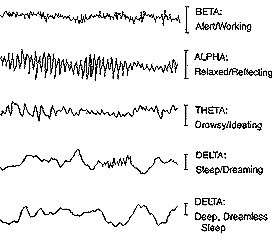
There are four categories of these
brainwaves. They range from the high amplitude, low frequency delta
to the low amplitude, high frequency beta. Men, women and children
of all ages experience the same characteristic brainwaves. They are
consistent across cultures and country boundaries.
During meditation brain waves alter.
-
BETA - 13-30 cycles per
second - awaking awareness, extroversion, concentration,
logical thinking - active conversation. A debater would be
in high beta. A person making a speech, or a teacher, or a
talk show host would all be in beta when they are engaged in
their work.
-
ALPHA - 7-13 cycles per
second - relaxation times, non-arousal, meditation, hypnosis
-
THETA - 4-7 cycles per
second - day dreaming, dreaming, creativity, meditation,
paranormal phenomena, out of body experiences, ESP, shamanic
journeys.
A person who is driving on a
freeway, and discovers that they can’t recall the last five
miles, is often in a theta state - induced by the process of
freeway driving. This can also occur in the shower or tub or
even while shaving or brushing your hair. It is a state
where tasks become so automatic that you can mentally
disengage from them. The ideation that can take place during
the theta state is often free flow and occurs without
censorship or guilt. It is typically a very positive mental
state.
NEWS ARTICLES
-
Meditation found to increase brain size
PhysOrg - January 31, 2006
-
Meditation Shown to Light Up Brains of
Buddhists
Yahoo - May 2003
Using new scanning techniques, neuroscientists have discovered
that certain areas of the brain light up constantly in
Buddhists, which indicates positive emotions and good mood.

-
"We can now hypothesize with some
confidence that those apparently happy, calm Buddhist souls one
regularly comes across in places such as Dharamsala, India,
really are happy," Professor Owen Flanagan, of Duke University
in North Carolina, said.
Dharamsala is the home base of exiled
Tibetan leader the Dalai Lama.
The scanning studies by scientists at the University of
Wisconsin at Madison showed activity in the left prefrontal
lobes of experienced Buddhist practitioners. The area is linked
to positive emotions, self-control and temperament.
Other research by Paul Ekman, of the University of California
San Francisco Medical Center, suggests that meditation and
mindfulness can tame the amygdala, an area of the brain which is
the hub of fear memory.
Ekman discovered that experienced Buddhists were less likely to
be shocked, flustered, surprised or as angry as other people.
Flanagan believes that if the findings of the studies can be
confirmed they could be of major importance.
-
Meditation mapped in Monks

During
meditation, people often feel a sense of no space
March 1, 2002 - BBC
Scientists investigating the effect of the meditative state on
Buddhist monk’s brains have found that portions of the organ
previously active become quiet, whilst pacified areas become
stimulated.
Andrew Newberg, a radiologist at the University of Pennsylvania,
US, told BBC World Service’s Discovery programme:
Using a brain imaging technique,
Newberg and his team studied a
group of Tibetan Buddhist monks as they meditated for
approximately one hour.
When they reached a transcendental high, they were asked to pull
a kite string to their right, releasing an injection of a
radioactive tracer. By injecting a tiny amount of radioactive
marker into the bloodstream of a deep meditator, the scientists
soon saw how the dye moved to active parts of the brain.
Sense of space
Later, once the subjects had finished meditating, the regions
were imaged and the meditation state compared with the normal
waking state.
The scans provided remarkable clues about what goes on in the
brain during meditation.
In addition, a notable decrease in
activity in the back part of the brain, or parietal lobe,
recognized as the area responsible for orientation, reinforced
the general suggestion that meditation leads to a lack of
spatial awareness.
Dr Newberg explained:
Prayer power
The complex interaction between different areas of the brain
also resembles the pattern of activity that occurs during other
so-called spiritual or mystical experiences.
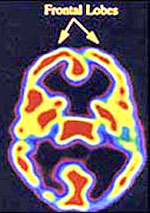
Brain
Images provide painless study
Dr Newberg’s earlier
studies have involved the brain activity of Franciscan nuns
during a type of prayer known as "centering".
As the prayer has a verbal element other parts of the brain are
used but Dr Newberg also found that they, "activated the
attention area of the brain, and diminished activity in the
orientation area."
This is not the first time that scientists have investigated
spirituality. In 1998, the healing benefits of prayer were
alluded to when a group of scientists in the US studied how
patients with heart conditions experienced fewer complications
following periods of "intercessory prayer".
Inner world
And at the annual meeting of the American Association for the
Advancement of Science in Boston last month, scientists from
Stanford University detailed their research into the positive
affects that hypnotherapy can have in helping people cope with
long-term illnesses.
Scientific study of both the physical world and the inner world
of human experiences are, according to Dr Newberg, equally
beneficial.
He added:
-
Areas of the brain activated during
meditation
Tracing the Synapses of Spirituality
June 17, 2001 - Washington
Post
In Philadelphia, a researcher discovers areas of the brain that are
activated during meditation. At two other universities in San Diego
and North Carolina, doctors study how epilepsy and certain
hallucinogenic drugs can produce religious epiphanies. And in
Canada, a neuroscientist fits people with magnetized helmets that
produce "spiritual" experiences for the secular.
The work is part of a broad new effort by scientists around the
world to better understand religious experiences, measure them, and
even reproduce them. Using powerful brain imaging technology,
researchers are exploring what mystics call nirvana, and what
Christians describe as a state of grace. Scientists are asking
whether spirituality can be explained in terms of neural networks,
neurotransmitters and brain chemistry.
What creates that transcendental feeling of being one with the
universe? It could be the decreased activity in the brain’s parietal
lobe, which helps regulate the sense of self and physical
orientation, research suggests. How does religion prompt divine
feelings of love and compassion?
Possibly because of changes in the
frontal lobe, caused by heightened concentration during meditation.
Why do many people have a profound sense that religion has changed
their lives? Perhaps because spiritual practices activate the
temporal lobe, which weights experiences with personal significance.
-
"The brain is set up in such a way
as to have spiritual experiences and religious experiences,"
said Andrew Newberg, a Philadelphia scientist who authored the
book "Why God Won’t Go Away."
-
"Unless there is a fundamental
change in the brain, religion and spirituality will be here for
a very long time. The brain is predisposed to having those
experiences and that is why so many people believe in God."
The research may represent the bravest
frontier of brain research. But depending on your religious beliefs,
it may also be the last straw. For while Newberg and other
scientists say they are trying to bridge the gap between science and
religion, many believers are offended by the notion that God is a
creation of the human brain, rather than the other way around.
-
"It reinforces atheistic assumptions
and makes religion appear useless," said Nancey Murphy, a
professor of Christian philosophy at Fuller Theological Seminary
in Pasadena, Calif.
-
"If you can explain religious experience
purely as a brain phenomenon, you don’t need the assumption of
the existence of God."
Some scientists readily say the research
proves there is no such thing as God. But many others argue that
they are religious themselves, and that they are simply trying to
understand how our minds produce a sense of spirituality.
Newberg, who was catapulted to center stage of the
neuroscience-religion debate by his book and some recent experiments
he conducted at the University of Pennsylvania with co-researcher
Eugene D’Aquili, says he has a sense of his own spirituality, though
he declined to say whether he believed in God because any answer
would prompt people to question his agenda. "I’m really not trying
to use science to prove that God exists or disprove God exists," he
said.
Newberg’s experiment consisted of taking brain scans of
Tibetan
Buddhist meditators as they sat immersed in contemplation. After
giving them time to sink into a deep meditative trance, he injected
them with a radioactive dye. Patterns of the dye’s residues in the
brain were later converted into images.
Newberg found that certain areas of the brain were altered during
deep meditation. Predictably, these included areas in the front of
the brain that are involved in concentration. But Newberg also found
decreased activity in the parietal lobe, one of the parts of the
brain that helps orient a person in three-dimensional space.
-
"When people have spiritual
experiences they feel they become one with the universe and lose
their sense of self," he said.
-
"We think that may be because of
what is happening in that area ‚ if you block that area you lose
that boundary between the self and the rest of the world. In
doing so you ultimately wind up in a universal state."
Across the country, at the University of
California in San Diego, other neuroscientists are studying why
religious experiences seem to accompany epileptic seizures in some
patients. At Duke University, psychiatrist Roy Mathew is studying
hallucinogenic drugs that can produce mystical experiences and have
long been used in certain religious traditions.
Could the flash of wisdom that came over
Siddhartha Gautama ‚ the
Buddha ‚ have been nothing more than his parietal lobe quieting
down? Could the voices that Moses and Mohammed heard on remote
mountain tops have been just a bunch of firing neurons‚ an
illusion? Could Jesus’s conversations with God have been a mental
delusion?
Newberg won’t go so far, but other proponents of the new brain
science do. Michael Persinger, a professor of neuroscience at
Laurentian University in Sudbury, Ontario, has been conducting
experiments that fit a set of magnets to a helmet-like device. Persinger runs what amounts to a weak electromagnetic signal around
the skulls of volunteers.
Four in five people, he said, report a "mystical experience, the
feeling that there is a sentient being or entity standing behind or
near" them. Some weep, some feel God has touched them, others become
frightened and talk of demons and evil spirits.
His research, said Persinger, showed
that "religion is a property of the brain, only the brain and has
little to do with what’s out there."
Those who believe the
new science disproves the existence of God say
they are holding up a mirror to society about the destructive power
of religion. They say that religious wars, fanaticism and
intolerance spring from dogmatic beliefs that particular gods and
faiths are unique, rather than facets of universal brain chemistry.
-
"It’s irrational and dangerous when
you see how religiosity affects us," said Matthew Alper, author
of "The God Part of the Brain," a book about the neuroscience of
belief.
-
"During times of prosperity, we are contented. During
times of depression, we go to war. When there isn’t enough food
to go around, we break into our spiritual tribes and use our
gods as justification to kill one another."
While Persinger and Alper count
themselves as atheists, many scientists studying the neurology of
belief consider themselves deeply spiritual.
James Austin, a neurologist, began practicing
Zen meditation during
a visit to Japan. After years of practice, he found himself having
to re-evaluate what his professional background had taught him.
-
"It was decided for me by the
experiences I had while meditating," said Austin, author of the
book "Zen and the Brain" and now a philosophy scholar at the
University of Idaho.
-
"Some of them were quickenings, one was a
major internal absorption ‚ an intense hyper-awareness, empty
endless space that was blacker than black and soundless and
vacant of any sense of my physical bodily self. I felt deep
bliss. I realized that nothing in my training or experience had
prepared me to help me understand what was going on in my brain.
It was a wake-up call for a neurologist."
Austin’s spirituality doesn’t involve a
belief in God ‚ it is more in line with practices associated with
some streams of Hinduism and Buddhism. Both emphasize the importance
of meditation and its power to make an individual loving and
compassionate‚ most Buddhists are disinterested in whether God
exists.
But theologians say such practices don’t describe most people’s
religiousness in either eastern or western traditions.
-
"When these people talk of religious
experience, they are talking of a meditative experience," said
John Haught, a professor of theology at Georgetown University.
-
"But religion is more than that. It involves commitments and
suffering and struggle ‚ it’s not all meditative bliss. It also
involves moments when you feel abandoned by God."
-
"Religion is visiting widows and orphans," he said. "It is
symbolism and myth and story and much richer things. They have
isolated one small aspect of religious experience and they are
identifying that with the whole of religion."
Belief and faith, argue believers, are
larger than the sum of their brain parts:
-
"The brain is the hardware through
which religion is experienced," said Daniel Batson, a University
of Kansas psychologist who studies the effect of religion on
people.
-
"To say the brain produces religion is like saying a
piano produces music."
At the Fuller Theological Seminary’s
school of psychology, Warren Brown, a cognitive neuropsychologist,
said,
-
"Sitting where I’m sitting and
dealing with experts in theology and Christian religious
practice, I just look at what these people know about
religiousness and think they are not very sophisticated. They
are sophisticated neuroscientists, but they are not scholars in
the area of what is involved in various forms of religiousness."
At the heart of the critique of the
new brain research is what one theologian at St. Louis
University called the "nothing-butism" of some scientists ‚ the notion that all
phenomena could be understood by reducing them to basic units that
could be measured.
And finally, say believers, if God existed and created the universe,
wouldn’t it make sense that he would install machinery in our brains
that would make it possible to have mystical experiences?
-
"Neuroscientists are taking the
viewpoints of physicists of the last century that everything is
matter," said Mathew, the Duke psychiatrist.
-
"I am open to the
possibility that there is more to this than what meets the eye.
I don’t believe in the omnipotence of science or that we have a
foolproof explanation."
Back to Top
Third Eye -
Pineal Gland
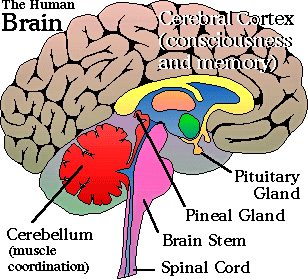
In the physical body the eye views
objects upside down. It sends the image of what it observes to the
brain which interprets the image and makes it appear right side-up
to us.
But the human body has another physical eye whose function has long
been recognized by humanity. It is called the ’Third Eye’ which in
reality is the Pineal Gland. It is long thought to have mystical
powers. Many consider it the Spiritual Third Eye, our Inner Vision.
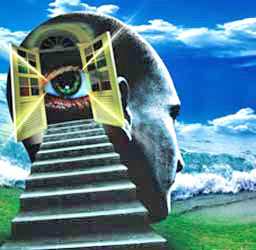
It is located in the geometric center of
the brain. This correlates to the location of the Great Pyramid in
the center of the physical planet.
The Pineal Gland is about the size of a pea, and is in the center of
the brain in a tiny cave behind and above the pituitary gland which
lies a little behind the root of the nose. It is located directly
behind the eyes, attached to the third ventricle.
The true function of this mysterious gland has long been
contemplated by philosophers and Spiritual Adepts. Ancient Greeks
believed the pineal gland to be our connection to the Realms of
Thought. Descartes called it the Seat of the Soul. This gland is
activated by Light, and it controls the various biorhythms of the
body. It works in harmony with the hypothalamus gland which directs
the body’s thirst, hunger, sexual desire and the biological clock
that determines our aging process.
When the pineal gland awakens one feels a pressure at the base of
the brain. This pressure will often be experienced when connecting
to higher frequency. A head injury can also activate the Third Eye -
Pineal Gland.
While the physiological function of the pineal gland has been
unknown until recent times, mystical traditions and esoteric schools
have long known this area in the middle of the brain to be the
connecting link between the physical and spiritual worlds.
Considered the most powerful and highest source of ethereal energy
available to humans, the pineal gland has always been important in
initiating supernatural powers. Development of psychic talents has
been closely associated with this organ of higher vision.
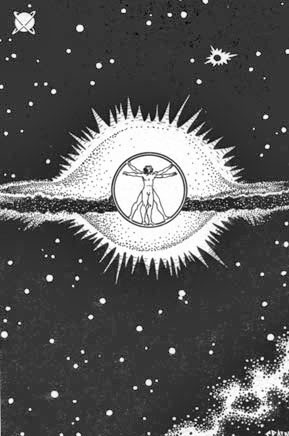
The third eye can see
beyond the physical as is looks out through the chakra system
when we meditate or
look for answers from higher frequencies.
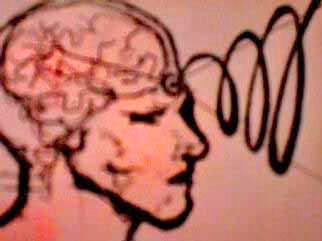
The pineal gland contains a complete map of the visual field of the
eyes
and it plays several
significant roles in human functioning.
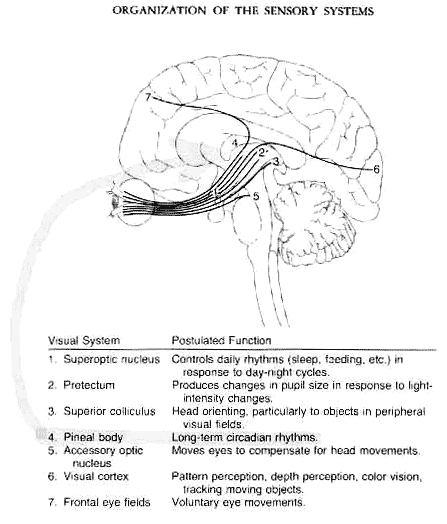
There is a pathway from the retinas to
the hypothalamus called the retinohypothalamic tract. It brings
information about light and dark cycles to a region of the
hypothalamus called the suprachiasmatic nucleus (SCN). From the
SCN,
nerve impulses travel via the pineal nerve (sympathetic nervous
system) to the pineal gland. These impulses inhibit the production
of melatonin. When these impulses stop (at night, when light no
longer stimulates the hypothalamus), pineal inhibition ceases and
melatonin is released. The pineal gland is therefore a
photosensitive organ and an important timekeeper for the human body.
Retinal research done with hamsters demonstrates another center for
melatonin production. Located in the retina, this center implies
that the eyes have their own built in circadian timepiece. This
retinal system is distinct from the brains body clock in the suprachiasmatic nucleus (SCN). Biologists found that they could
throw the retinal rhythms out of sync with other circadian cycles.
They also found that they could set and reset the retinal clock even
when the SCN was destroyed.
The retinal clock produces (stimulates the production of?)
melatonin. Researchers are now looking for the exact location(s) of
this clock in the human eye (and expect to find it). No one yet
knows what the separate clock is for or how it relates to the SCN.
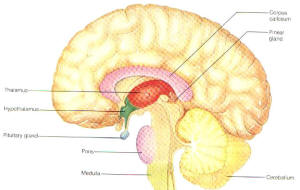 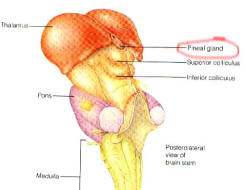
In some lower vertebrates the Epiphysis Cerebri -
Pineal Gland - has a well-developed eye-like structure; in
others though not organized as an eye, if functions as a light
receptor. In lower vertebrates, the pineal gland has an eye like
structure and it functions as a light receptor and is considered by
some to be the evolutionary forerunner of the modern eye.
The gland weighs little more than 0.1 gram. The gland is large in
children and begins to shrink with the onset of puberty. It appears
to play a major role in sexual development, hibernation in animals,
metabolism, and seasonal breeding. In humans it affects circadian
rhythms, sleep patterns (melatonin levels increase at night), and is
implicated in seasonal affective disorder. The abundant melatonin
levels in children is believed to inhibit sexual development. When
puberty arrives, melatonin production is reduced.
The pineal gland secretes melanin during times of relaxation and
visualization. As we are created by electromagnetic energy - and
react to EM energy stimuli around us - so does the pineal gland.
When activated, the pineal gland becomes the line of communication
with the higher planes. The crown chakra reaches down until its
vortex touches the pineal gland. Prana, or pure energy, is received
through this energy center in the head. With Practice the vibration
level of the astral body is raised, allowing it to separate from the
physical.
To activate the ’third eye’ and perceive higher dimensions, the
pineal gland and the pituitary body must vibrate in unison, which is
achieved through meditation and/or relaxation. When a correct
relationship is established between personality, operating through
the pituitary body, and the soul, operating through the pineal
gland, a magnetic field is created. The negative and positive forces
interact and become strong enough to create the ’light in the head.’
With this ’light in the head’ activated, astral projectors can
withdraw themselves from the body, carrying the light with them.
Astral travel, and other occult abilities, are closely associated
with the development of the ’light in the head ’. After physical
relaxation, concentration upon the pineal gland is achieved by
staring at a point in the middle of the forehead. Without straining
the muscles of the eye, this will activate the pineal gland and the
’third eye’. Beginning with the withdrawal of the senses and the
physical consciousness, the consciousness is centered in the region
of the pineal gland. The perceptive faculty and the point of
realization are centralized in the area between the middle of the
forehead and the pineal gland. The trick is to visualize, very
intently, the subtle body escaping through the trap door of the
brain. A popping sound may occur at the time separation of the
astral body in the area of the pineal gland.
Visualization exercises are the first step in directing the energies
in our inner systems to activate the ’third eye’. The magnetic field
is created around the pineal gland, by focusing the mind on the
midway point between the pineal gland and the pituitary body. The
creative imagination visualizes something, and the thought energy of
the mind gives life and direction to this form.
’Third eye’ development, imagination, and visualization are
important ingredients in many methods to separate from the physical
form. Intuition is also achieved through ’third eye’ development.
Knowledge and memory of the astral plane are not registered in full
waking consciousness until the intuition becomes strong enough.
Flashes of intuition come with increasing consistency as the ’third
eye’ as activated to a greater degree, through practice.
The pineal gland corresponds with divine thought after being touched
by the vibrating light of Kundalini. Kundalini starts its ascent
towards the head center after responding to the vibrations from the
’light in the head.’ The light is located at the top of the
sutratma,
or ’soul thread’, which passes down from the highest plane of our
being into the physical vehicle.
The ’third eye,’ or ’eye of Siva,’ the organ of spiritual vision, is
intimately related to karma, as we become more spiritual in the
natural course of evolution.
As human beings continue to evolve further out of matter, on the
journey from spirit to matter back to spirit, the pineal gland will
continue to rise from its state of age-long dormancy, bringing back
to humanity astral capacities and spiritual abilities.
At certain brainwave frequencies, a sense of ego boundary vanishes.
In the theta state, we are resting deeply and still conscious, at
the threshold of drifting away from or back into conscious
awareness. As the brain enters deeper states, our consciousness is
less concerned with the physical state, our ’third eye’ is active,
and separation becomes natural. Many native traditions and mystical
practices refer to the ability of ’seeing,’ or being aware of energy
fields at higher levels. This abstract awareness is much more
subjective and does not involve the normal level of mundane
consciousness, which is mostly concerned with self-identity. This
’seeing’ refers to the sight of the ’third eye’.
Consciousness is raised from an emotional nature into an illumined
awareness when the pineal gland is lifted from dormancy. If the
pineal gland is not yet fully developed, it will be in the course of
evolution. When our sense of ego and personality are set aside and
we keep our mental energy intact, we can become conscious of the
non-physical, our inner self, the subconscious, through different
practices to activate the ’light in the head.’
Back to Top
The Reptilian
Brain
The brain stem is the oldest and smallest region in the evolving
human brain. It evolved hundreds of millions of years ago and is
more like the entire brain of present-day reptiles. For this reason,
it is often called the ’reptilian brain’. Various clumps of cells in
the brain stem determine the brain’s general level of alertness and
regulate the vegetative processes of the body such as breathing and
heartbeat.
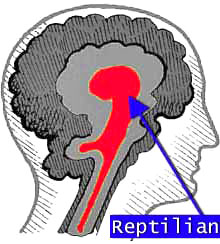
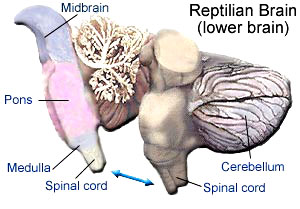
It’s similar to the brain possessed by
the hardy reptiles that preceded mammals, roughly 200 million years
ago. It’s ’preverbal’, but controls life functions such as autonomic
brain, breathing, heart rate and the fight or flight mechanism.
Lacking language, its impulses are instinctual and ritualistic. It’s
concerned with fundamental needs such as survival, physical
maintenance, hoarding, dominance, preening and mating. It is also
found in lower life forms such as lizards, crocodiles and birds. It
is at the base of your skull emerging from your spinal column.
The basic ruling emotions of love, hate, fear,
lust, and contentment
emanate from this first stage of the brain. Over millions of years
of evolution, layers of more sophisticated reasoning have been added
upon this foundation.
Our intellectual capacity for complex rational thought which has
made us theoretically smarter than the rest of the animal kingdom.
When we are out of control with rage, it is our reptilian brain
overriding our rational brain components. If someone says that they
reacted with their heart instead of their head. What they really
mean is that they conceded to their primitive emotions (the
reptilian brain based) as opposed to the calculations of the
rational part of the brain.
Back to Top
Memory
Memory is one of the activities of the human mind, much studied by
cognitive psychology. It is the capacity to retain an impression of
past experiences. There are multiple types of classifications for
memory based on duration, nature and retrieval of perceived items.
The main stages in the formation and retrieval of memory, from an
information processing perspective, are:
-
Encoding (processing of received
information by acquisition)
-
Storage (building a permanent
record of received information as a result of consolidation)
-
Retrieval (calling back the
stored information and use it in a suitable way to execute a
given task)
A basic and generally accepted
classification (depending on the duration of memory retention and
the amount of stored information during these stages) identifies
three distinct types of memory:
-
sensory memory
-
short-term memory
-
long-term memory
The first stage corresponds approximately to
the initial moment that an item is perceived. Some of this
information in the sensory area proceeds to the sensory store, which
is referred to as short-term memory.
Sensory memory is characterized by the
duration of memory retention from miliseconds to seconds and
short-term memory from seconds to minutes. Once the information is
stored, it can be retrieved in a period of time, which ranges from
days to years and this type of memory is called long-term memory.
The sensory and short-term memory are bio-electrical types of
memory, as they store information in form of electrical signals,
whereas the long-term memory is a bio-chemical type of memory.
When we are given a seven digit number, we can remember it only for
a few seconds and then forget (short term memory). On the other hand
we remember our telephone numbers, since we have stored it in our
brain after long periods of consolidation (long term memory).
The definition of working memory, which is erroneously used as a
synonym of short-term memory, is based on not only the duration of
memory retention but also the way how it is used in daily life
activities. For instance, when we are asked to multiply 45 with 4 in
our head, we have to perform a series of simple calculations
(addition and multiplications) to give the final answer. The process
of keeping in mind all this information for a short period of time
is called working memory.
Another good example is a chess player, who is playing with multiple
opponents at the same time and trying to remember the positions of
pieces in all games and using this information to make a good move,
when required. Long-term memory can further be classified as
declarative (explicit) and procedural (implicit).
Explicit memory requires conscious recall, in other words the
information must be called back consciously when it is required. If
this information is about our own lives (what we ate for breakfast
in this morning, our birth date etc.), it is called episodic memory,
if it concerns our knowledge about the world (capital of France,
presidents of US etc.), then it is called semantic memory.
Implicit memory is not based on the conscious recall of information
stored in our brain, but on the habituation or sensitization of
learned facts. We perform better in a given task each time we repeat
the task, that is we use our implicit memory without necessarily
remembering the previous experiences but using the previously
learned behaviours unconsciously. For example, classical
conditioning is one kind of implicit memory. Another example is
memory resulting from motor learning, which depends upon the
cerebellum and basal ganglia.
Articles
Back to Top
Messages From
Hypnotic States
As a Certified Hypnotherapist I have placed many clients in a
hypnotic state.
During a session clients can bring messages from:
Messages received through a hypnotic
state may not seem valid - but there could be a connection with
another aspect of the person’s physical reality.
Some people speak in ’tongues’ when hypnotized. This is called
Polyglot or Xenoglot.
Often people who have had traumatic experiences such as an alien
abduction - will go to a hypnotherapist to gain relive them and
release pain suffered or to help them understand their spiritual
purpose or personal lives.
Message gleamed through past life regression therapy allow the
individual - insight into a collective memory and greater
understanding of their behavior in this time line.
NEWS ARTICLES
Back to Top
|













